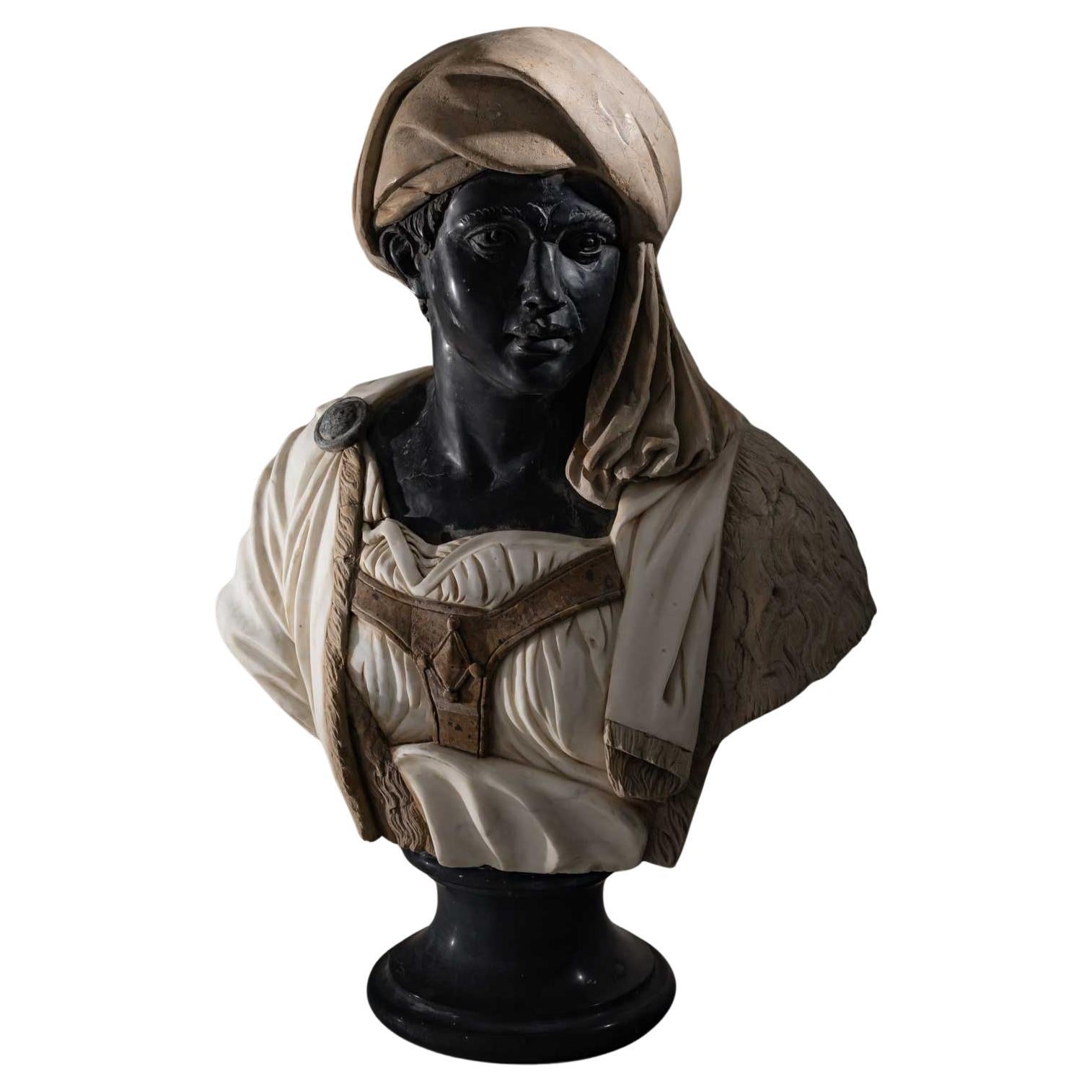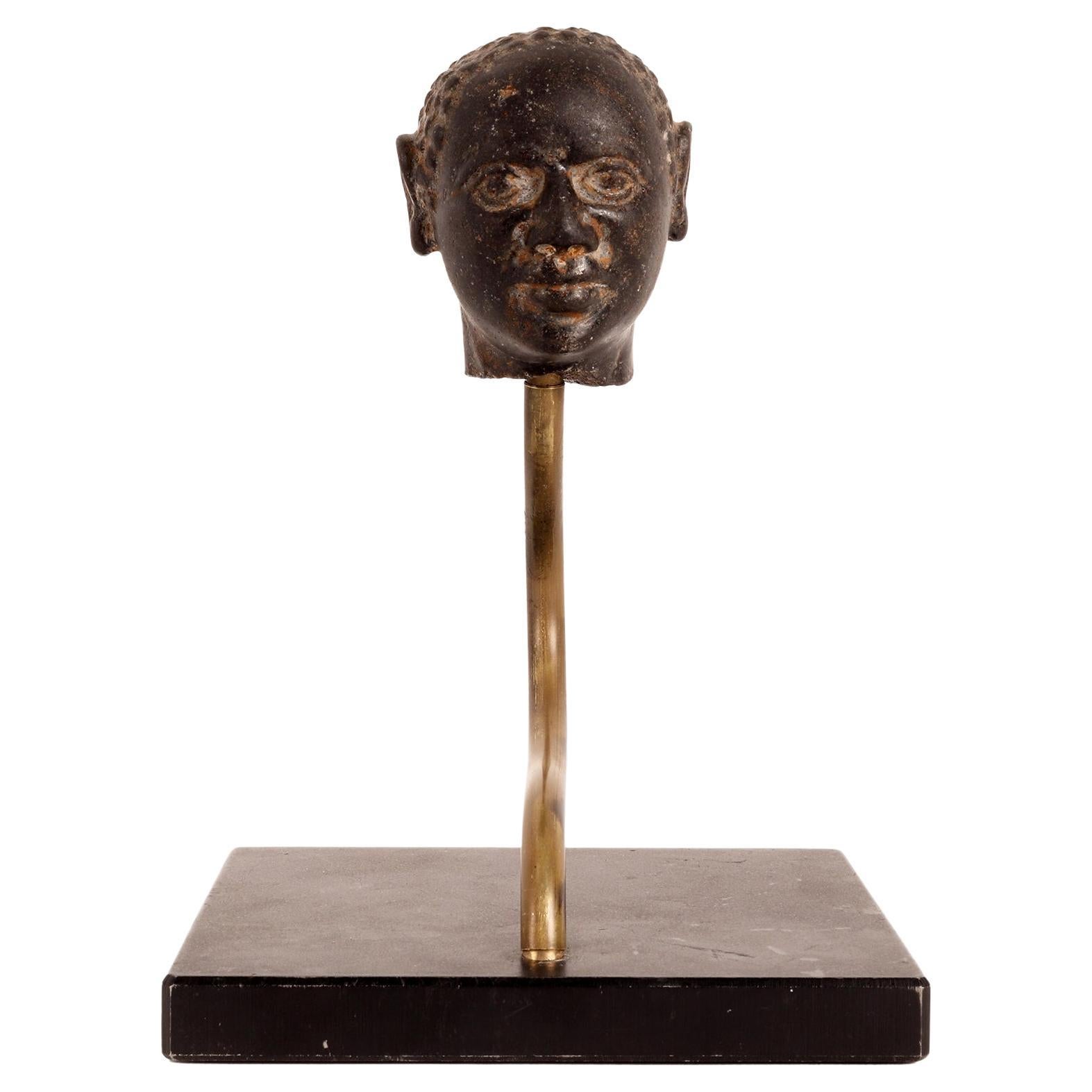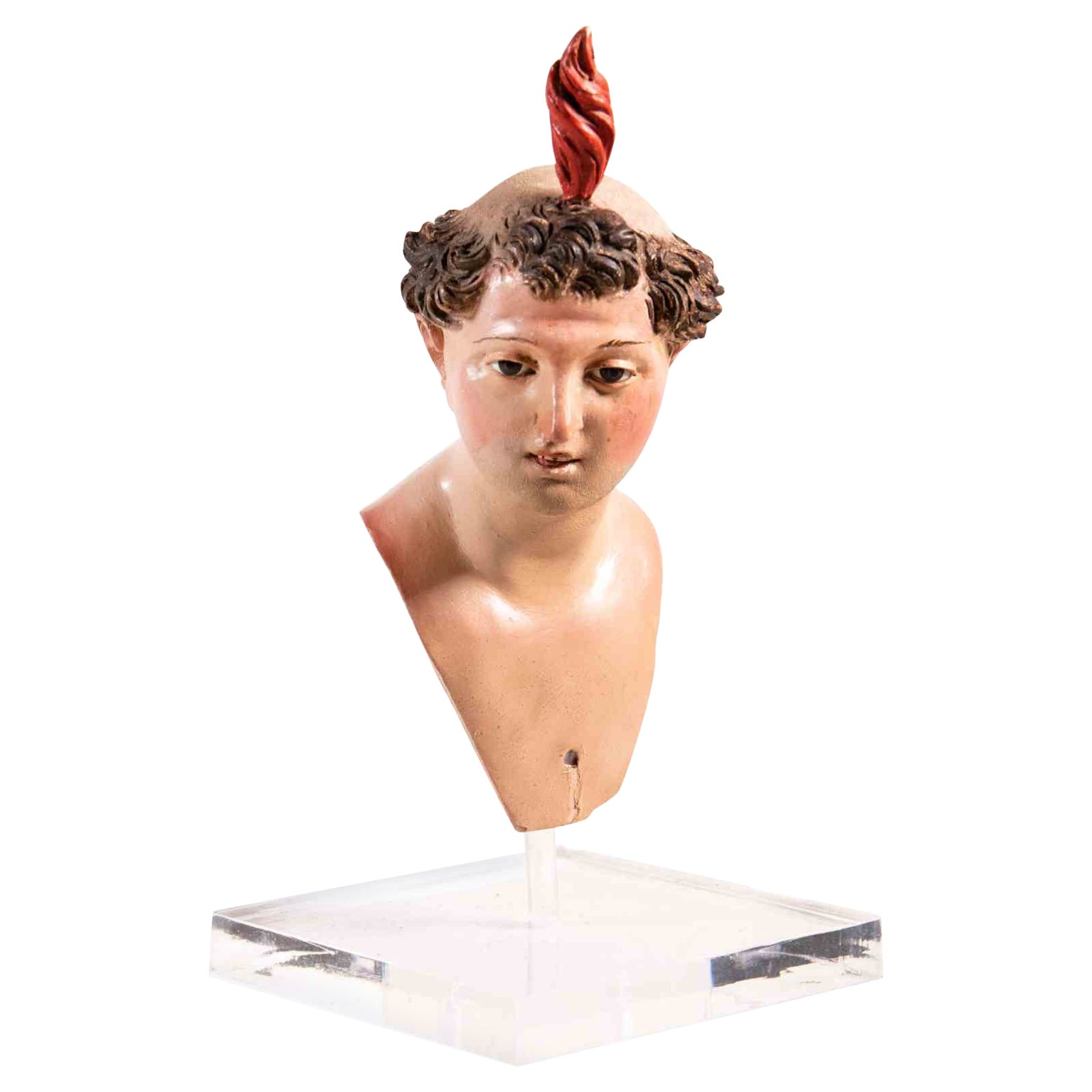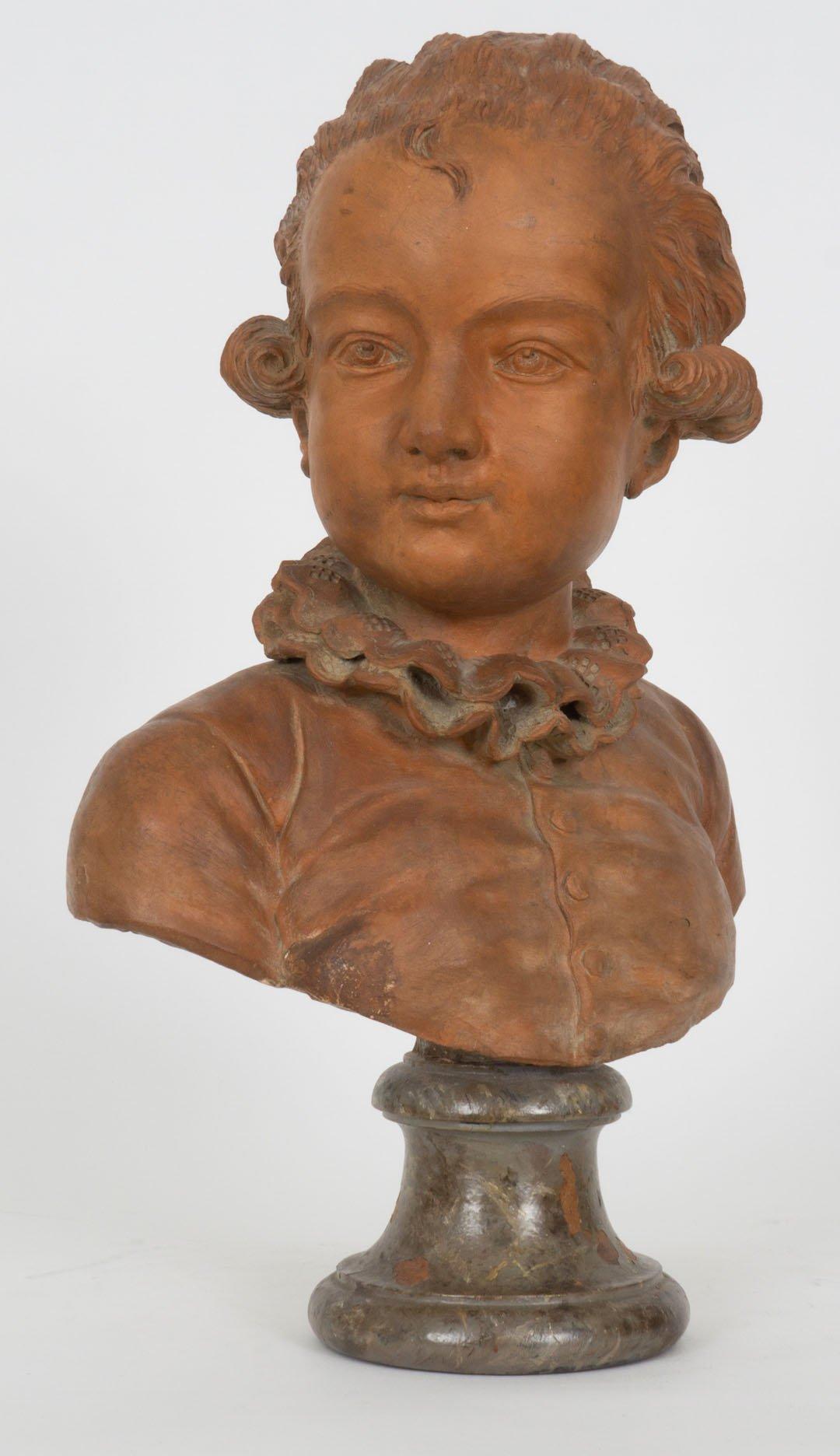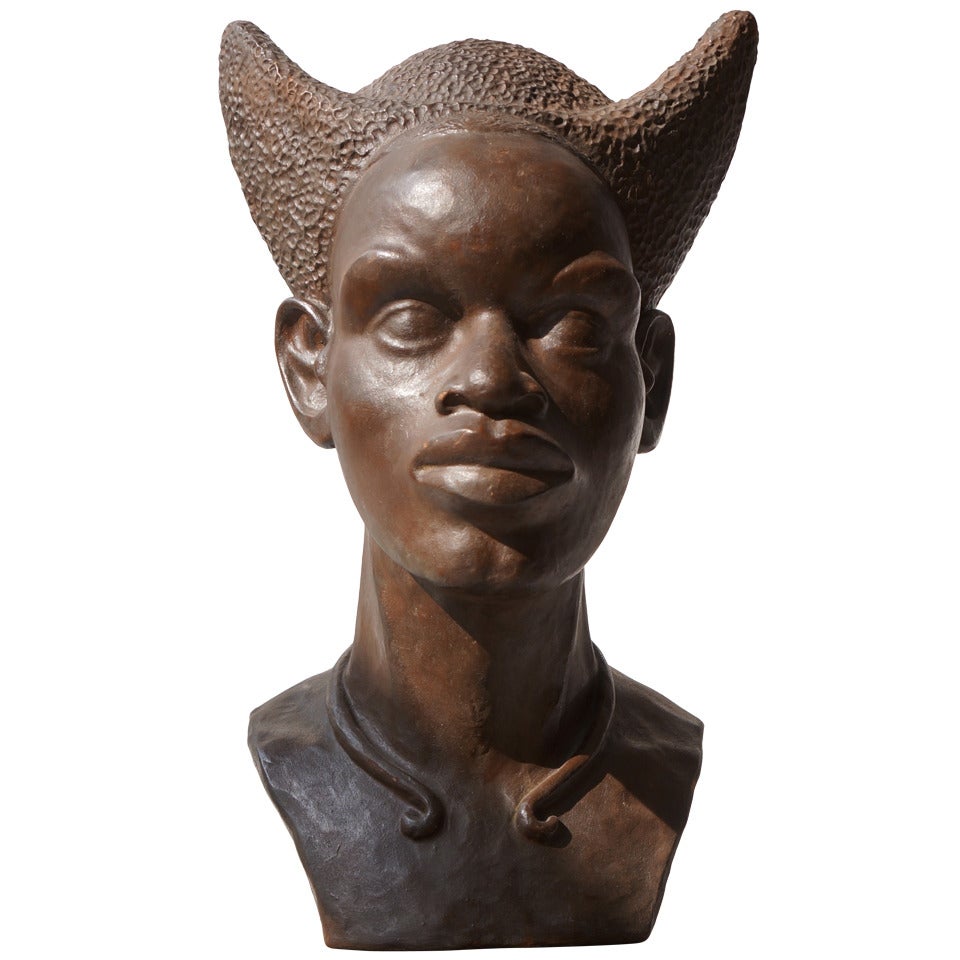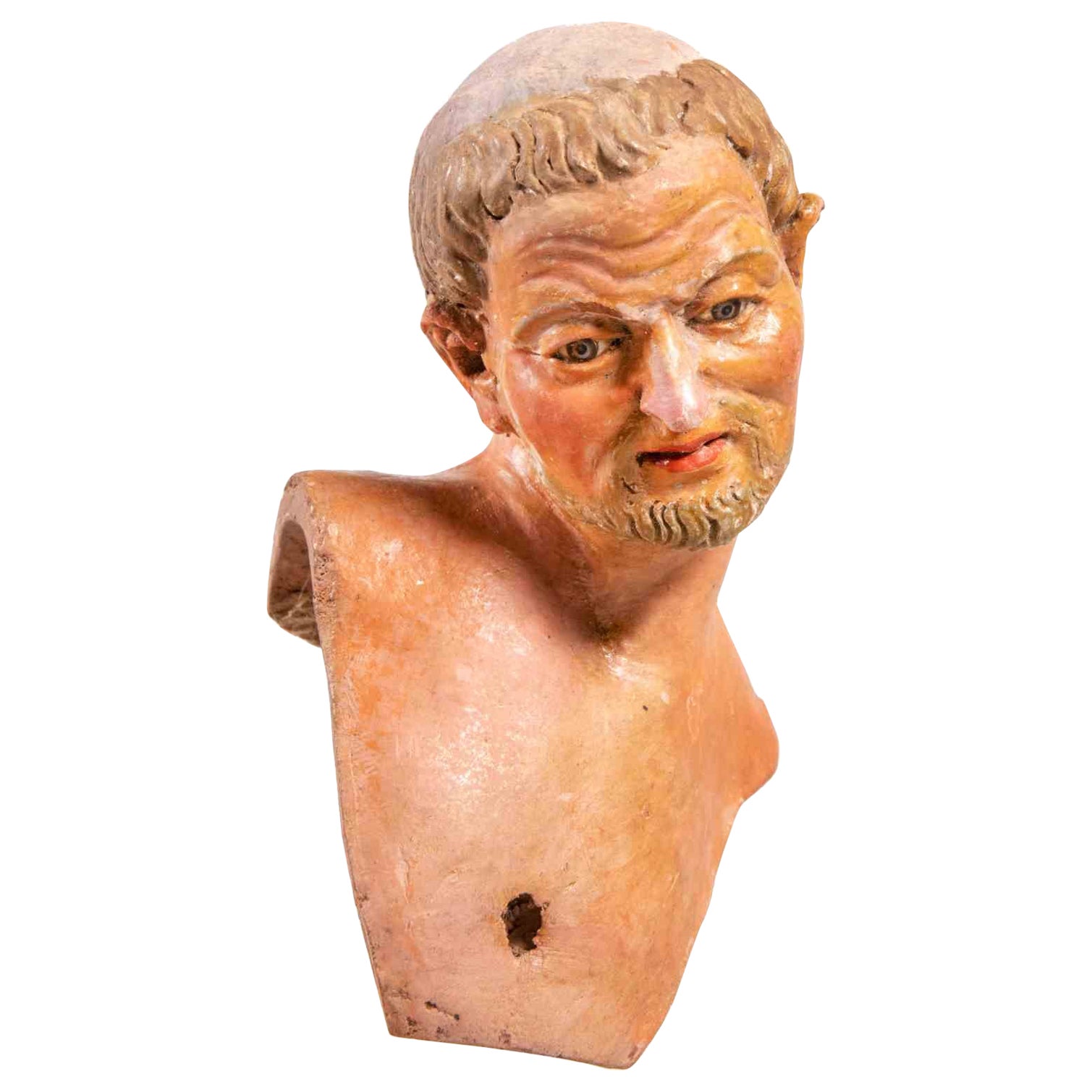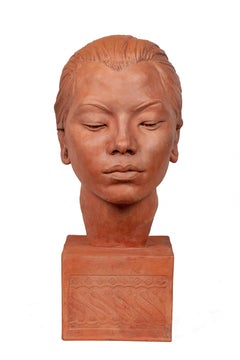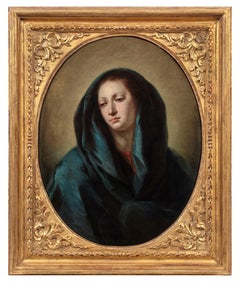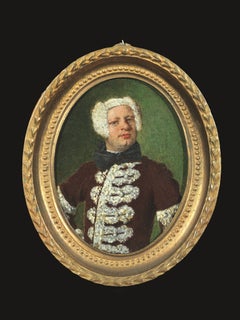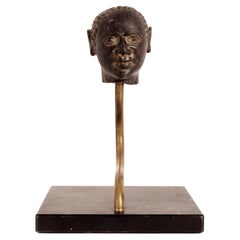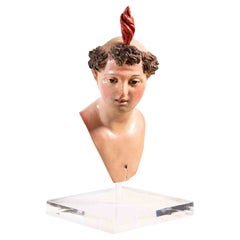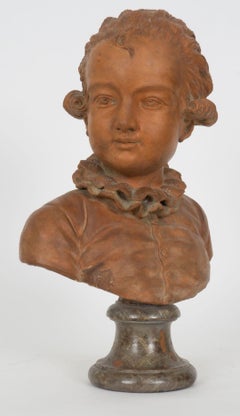Items Similar to Head of a Young African Man
Want more images or videos?
Request additional images or videos from the seller
1 of 4
Italian School, ca. 1800Head of a Young African Manca. 1800
ca. 1800
$28,500
£21,625.14
€24,726.42
CA$39,806.77
A$44,259.71
CHF 23,109.98
MX$538,748.50
NOK 294,873.29
SEK 276,282.18
DKK 184,537.81
Shipping
Retrieving quote...The 1stDibs Promise:
Authenticity Guarantee,
Money-Back Guarantee,
24-Hour Cancellation
About the Item
Provenance: Private Collection, Spain.
This intriguing and enigmatic sculpture depicts the head of a young African man emerging from a circular opening or window. He is seen in three-quarter profile, his eyes partially closed, but with a resolute expression punctuated by his surging hair. He seems neither an allegorical figure, nor an ethnographic type. Were it not for the highly unusual format, the specificity of his features would suggest that he is the subject of a portrait. The function of the work remains a mystery. Its scale, material, and degree of finish suggest that it was a model for a larger work—whether an architectural ornament, an element of a multi-figure composition, a funerary or commemorative monument, or some grand sculptural project.
As an individual head seen in isolation it seems to evoke a range of associations—resignation, resistance, solitude. And the visual ties to images of the head of Saint John the Baptist on a salver, whether or not intended by the artist, gives additional resonance to the piece. The octagonal surround as well as the inner frame are integral with the head, and as the work does not correspond to any familiar class of object—whether artistic, decorative, or utilitarian—it seems likely that our sculpture could have been retained in the studio of the unknown artist who modeled it. On the basis of its high quality and style, we have suggested that it is Italian of the late 18th or early 19th century, but as with its purpose, its origin and date remain to be discovered, although its beauty can be appreciated despite the lack of art-historical context.
- Creator:Italian School, ca. 1800 (Italian)
- Creation Year:ca. 1800
- Dimensions:Height: 9 in (22.86 cm)Width: 8.625 in (21.91 cm)
- Medium:
- Period:
- Condition:
- Gallery Location:New York, NY
- Reference Number:1stDibs: LU10212237532
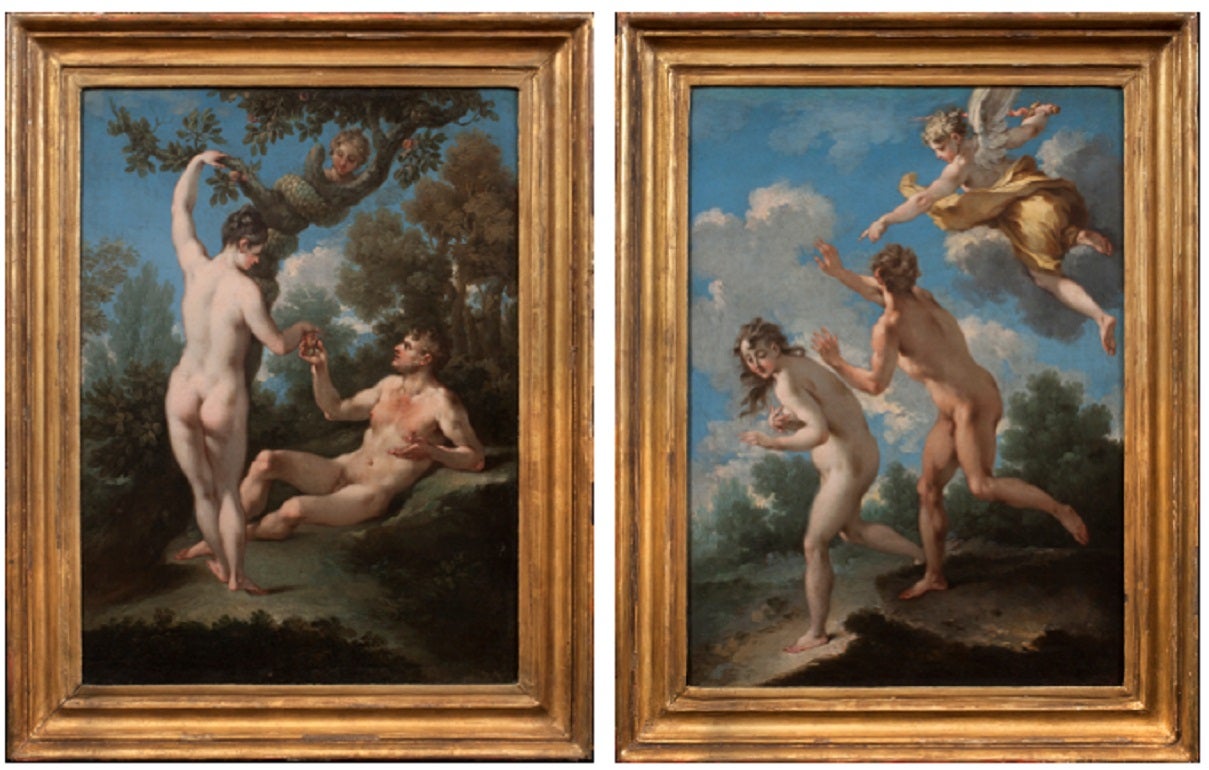
About the Seller
5.0
Recognized Seller
These prestigious sellers are industry leaders and represent the highest echelon for item quality and design.
Established in 1997
1stDibs seller since 2012
22 sales on 1stDibs
Typical response time: 5 hours
- ShippingRetrieving quote...Shipping from: New York, NY
- Return Policy
Authenticity Guarantee
In the unlikely event there’s an issue with an item’s authenticity, contact us within 1 year for a full refund. DetailsMoney-Back Guarantee
If your item is not as described, is damaged in transit, or does not arrive, contact us within 7 days for a full refund. Details24-Hour Cancellation
You have a 24-hour grace period in which to reconsider your purchase, with no questions asked.Vetted Professional Sellers
Our world-class sellers must adhere to strict standards for service and quality, maintaining the integrity of our listings.Price-Match Guarantee
If you find that a seller listed the same item for a lower price elsewhere, we’ll match it.Trusted Global Delivery
Our best-in-class carrier network provides specialized shipping options worldwide, including custom delivery.More From This Seller
View AllHead of a Classical Poet (Socrates?)
By Pier Francesco Mola
Located in New York, NY
Provenance:
Possibly Antonio Amici Moretti, Rome, 1690
Roy Clyde Gardner, Union, Mississippi, 1970s until 2004; by whom given to:
Mississippi Band of Choctaw Indians, 2004-2010
Lit...
Category
17th Century Baroque Paintings
Materials
Canvas, Oil
Portrait of Ni-Polog
Located in New York, NY
Signed, dated, and inscribed on the verso:
Malvina Hoffman/ Den Pasar/ “Nipolog”-/ © 1932/ Bali
Provenance:
The artist; her estate.
Literature:
Mal...
Category
1930s Realist Sculptures
Materials
Terracotta
Head of the Virgin
Located in New York, NY
Provenance: Private Collection, Paraguay.
This unpublished Head of the Virgin is a new addition to the rich corpus of paintings by Giovanni Battista Tiepolo. While the artist freque...
Category
18th Century Old Masters Figurative Paintings
Materials
Oil, Canvas
Portrait of a Bewigged Gentleman
By Vittore Ghislandi
Located in New York, NY
Vittore Ghislandi, called Fra Galgario
Provenance:
Robert L. and Bertina Suida Manning, New York, ca. 1966-1996
Private Collection, USA
Exhibited:
“Eighteenth Century European Pai...
Category
18th Century Baroque Paintings
Materials
Copper
Portrait of a Gentleman
By Ippolito Scarsella (Scarsellino)
Located in New York, NY
Provenance: Suida-Manning Collection, New York
Private Collection
Exhibited: Venetian Paintings of the Sixteenth Century, Finch College Museum of Art, New York, October 30-December 15, 1963, no. 31.
Veronese & His Studio in North American Collections, Birmingham Museum of Art, Oct. 1-Nov. 15, 1972, and Montgomery Museum of Fine Arts, Dec. 5-Dec. 31, 1972
Literature: Robert L. Manning, A Loan Exhibition of Venetian Paintings of the Sixteenth Century, exh. cat. New York 1963, cat. no. 31ill., as by Veronese
Stephen Clayton and Edward Weeks, eds., introduction by David Rosand, Veronese & His Studio in North American Collections, Birmingham 1972, as by Veronese, p. 38 ill.
Terisio Pignatti, Veronese, Venice 1976, I, p. 199, cat. no. A225, II, fig. 908, as attributed to Veronese
Terisio Pignatti and Filippo Pedrocco, Veronese; catalogo completo dei dipinti, Florence 1991, no. 54°, as attributed to Veronese.
Terisio Pignatti and Filippo Pedrocco, Veronese, Milan 1995, II, pp. 517-518ill., cat. no. A 56, under attributed paintings, by Veronese and workshop)
John Garton, Grace and Grandeur; The Portraiture of Paolo Veronese, London-Turnhout 2008, p. 237, fig. 77, cat. no. R16, as workshop of Veronese.
Scarsellino’s art is widely regarded as critical link between the Renaissance and the Baroque styles in Emilian painting; not only was he an important transmitter of the heritage of the Renaissance, but he was also open to innovative ideas, and was one of the earliest to experiment with the trend to naturalism that would become fundamental to art of the new century. Born around 1550, he received his earliest training from his father Sigismondo, an architect and painter; it was probably while working at his father’s side as a youth that he acquired the nickname Scarsellino, or “little Scarsella”. After absorbing the principles of his art in Ferrara and Parma, he went to Venice in 1570, staying for four years and working in the shop of Veronese. In the following decade, his art —especially in terms of its piety and its development of landscape— demonstrates a strong sympathy with that of the Carracci, with whom he worked in 1592-1593 at the Palazzo dei Diamanti in Ferrara. Maria Angela Novelli and later Alessandra Frabetti both propose that Scarsellino traveled to Rome, although such a trip has not been documented; if he did travel to Rome, it probably would have occurred during the years that Scarsellino’s colleagues Agostino and Annibale Carracci were there, that is, beginning in 1595 and until 1609. The last decades of Scarsellino’s career again involve stylistic experimentation, this time in a manner that would bring his work very close to the progressive figurative naturalism of Carlo Bononi and prepare the way for Guercino.
The present portrait of a distinguished gentleman had been long thought to be by Paolo Veronese and was in fact attributed to him by such distinguished connoisseurs as Adolfo Venturi and Wilhelm Suida. The portrait’s style is, however, distinct from Veronese’s, although clearly indebted to it, and the attribution to the young Scarsellino is wholly convincing. The painting would then date from the 1570s – a date confirmed by the costume the subject wears. The puffed hat that appears in the painting had a rather short-lived vogue in the early 1570s. One sees it in Giambattista Moroni’s Portrait of Count...
Category
18th Century and Earlier Baroque Portrait Paintings
Materials
Canvas, Oil
The Infant Saint John the Baptist with a Lamb
Located in New York, NY
Provenance:
James Byrnes, Los Angeles (1917-2011)
Giusto Le Court was born Josse or Justus de Corte in the Flemish city of Ypres. His father Jean was a sculptor and presumably his earliest training was with him before he entered the studio of Cornelis van Mildert. The young artist was clearly influenced by the dominant Flemish sculptor of the time, Artus Quellinus the Elder, with whom he may have worked on the decoration of the Amsterdam City Hall.
Following the lead of many northern artists he travelled to Rome, perhaps more than once, before settling in Venice around 1655. It was there, as one of a colony of expatriate artists, that he made his name as a sculptor. One of his first Venetian commissions was for the monument to Alvise Mocenigo in the Church of San Lazzaro dei Mendicanti, where Le Court sculpted the marble figures of Strength and Justice. He also collaborated with the celebrated architect Baldassare Longhena, most famously for the high altar of Santa Maria della Salute, where he carved the multi-figured altarpiece depicting the Queen of Heaven Expelling the Plague.
The present marble sculpture depicts the infant Saint John the Baptist, reclining, wearing his traditional hair-shirt, embracing a lamb, and holding the bottom of his attribute, a reed cross. Attached to his shirt is a baptismal cup, with which he would become associated later in his life. Veneration of the infant Saint John the Baptist was prevalent throughout Italy and images of the saint in childhood—often called “Giovannino,” or little John...
Category
17th Century Renaissance Sculptures
Materials
Marble
You May Also Like
Marble Bust of an African Man, Italy 20th Century
Located in Greding, DE
Life-size bust of a dark-skinned man with a headdress and light-coloured clothing. The bust is made of different types of coloured marble and carved by hand.
Category
20th Century Italian Neoclassical Figurative Sculptures
Materials
Marble
Head of a man in black granite, iron base, Russia, early 18th century.
Located in Milan, IT
Sculpture depicting a man head, made out of black granite, mounted on a square iron base with a brass support. Russia early 18th century.
Category
Antique Early 18th Century Russian Figurative Sculptures
Materials
Granite, Iron
Head of Man, Italy, 18th Century
Located in Roma, IT
Head of man is a sculpture realized in polychrome ceramic with glass eyes.
Neaples, 18th Century.
Category
Antique 18th Century Italian Figurative Sculptures
Materials
Ceramic
Terracotta Bust of a Young Gentleman, Late 18th Century French Sculpture
Located in Beachwood, OH
After Philippe-Laurent Roland (French, 1746-1816)
Bust of a Young Man, 1772
Terra cotta set on painted wood pedestal
Signed and dated at back
16.5 x 11 x 8 inches
Philippe-Laurent R...
Category
1770s Figurative Sculptures
Materials
Terracotta
Bust of a Congolese Mangbetu Woman by F.X. Goddard
By F.X. Goddard
Located in Antwerp, BE
A bust of a Congolese Mangbetu woman by F.X. Goddard and A. Nauwelaers.
François-Xavier GODDARD (1912-2006) (Belgium) is an artist born in 1912.
Category
Early 20th Century Belgian Mid-Century Modern Busts
Materials
Plaster
Head of Man, Italy, 18th Century
Located in Roma, IT
Head of man realized in polychrome ceramic with glass eyes.
Neaples, 18th Century.
Category
Antique 18th Century Italian Figurative Sculptures
Materials
Ceramic
More Ways To Browse
Sculpture Terracotta Man
Terracotta Saint
18th Century Salver
David Adickes Bronze
Dressage Saddle Used
Howling Wolf
Julien Marinetti
Karin Beek
Kaws Black Dissected
Kaws Ceramic
Marcus Lyon
Marian Owczarski
Modigliani Tete
Paolo Troubetzkoy
Rennert Inner Dialogue
Richard Macdonald Gymnast
Vespa Figurative Sculpture
Viktor Freso
